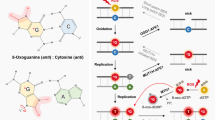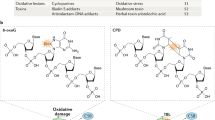Abstract
Guanine in DNA is a major oxidation target owing to its low ionization potential (IP), and there is often an inverse correlation between damage frequency and sequence-dependent variation in guanine IP. We report that the biological oxidant nitrosoperoxycarbonate (ONOOCO2–) paradoxically selects guanines with the highest IP in GC-containing contexts. Along with sequence-dependent variation in damage chemistry, this behavior points to factors other than charge migration as determinants of genomic DNA oxidation.
This is a preview of subscription content, access via your institution
Access options
Subscribe to this journal
Receive 12 print issues and online access
$259.00 per year
only $21.58 per issue
Buy this article
- Purchase on Springer Link
- Instant access to full article PDF
Prices may be subject to local taxes which are calculated during checkout


Similar content being viewed by others
References
Hall, D.B., Holmlin, R.E. & Barton, J.K. Nature 382, 731–735 (1996).
Ly, D., Kan, Y., Armitage, B. & Schuster, G.B. J. Am. Chem. Soc. 118, 8747–8748 (1996).
Saito, I. et al. J. Am. Chem. Soc. 120, 12686–12687 (1998).
Dedon, P.C. & Tannenbaum, S.R. Arch. Biochem. Biophys. 423, 12–22 (2004).
Shafirovich, V., Dourandin, A., Huang, W. & Geacintov, N.E. J. Biol. Chem. 276, 24621–24626 (2001).
Tretyakova, N.Y. et al. Mutat. Res. 447, 287–303 (2000).
Cloutier, J.F. et al. J. Mol. Biol. 313, 539–557 (2001).
Joffe, A., Geacintov, N.E. & Shafirovich, V. Chem. Res. Toxicol. 16, 1528–1538 (2003).
Ravanat, J.L., Saint-Pierre, C. & Cadet, J. J. Am. Chem. Soc. 125, 2030–2031 (2003).
Dong, M. et al. Mutat. Res. 594, 120–134 (2006).
Spassky, A. & Angelov, D. Biochemistry 36, 6571–6576 (1997).
Misiaszek, R., Crean, C., Geacintov, N.E. & Shafirovich, V. J. Am. Chem. Soc. 127, 2191–2200 (2005).
Douki, T. & Cadet, J. Free Rad. Res. 24, 369–380 (1996).
Rodriguez, H. et al. Biochemistry 38, 16578–16588 (1999).
Acknowledgements
This research was supported by the National Cancer Institute (CA110261 and CA026731) and the National Institute of Environmental Health Sciences (ES002109).
Author information
Authors and Affiliations
Corresponding author
Ethics declarations
Competing interests
The authors declare no competing financial interests.
Supplementary information
Supplementary Fig. 1
Illustrative sequencing gel (PDF 33 kb)
Supplementary Fig. 2
Comparison of Fpg- and piperidine-induced DNA cleavage (PDF 94 kb)
Supplementary Fig. 3
Damage in single-stranded oligos (PDF 73 kb)
Supplementary Fig. 4
Illustrative LMPCR gel (PDF 229 kb)
Rights and permissions
About this article
Cite this article
Margolin, Y., Cloutier, JF., Shafirovich, V. et al. Paradoxical hotspots for guanine oxidation by a chemical mediator of inflammation. Nat Chem Biol 2, 365–366 (2006). https://doi.org/10.1038/nchembio796
Received:
Accepted:
Published:
Issue Date:
DOI: https://doi.org/10.1038/nchembio796
This article is cited by
-
Widespread 8-oxoguanine modifications of miRNA seeds differentially regulate redox-dependent cancer development
Nature Cell Biology (2023)
-
8-Oxoguanine: from oxidative damage to epigenetic and epitranscriptional modification
Experimental & Molecular Medicine (2022)
-
A mechanism for oxidative damage repair at gene regulatory elements
Nature (2022)
-
OGG1-DNA interactions facilitate NF-κB binding to DNA targets
Scientific Reports (2017)
-
Erratum: Corrigendum: Paradoxical hotspots for guanine oxidation by a chemical mediator of inflammation
Nature Chemical Biology (2007)



